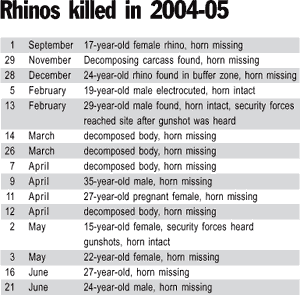 On 20 July, a decomposing carcass of a rhino was discovered near Bhalu Tappu in Royal Chitwan National Park. It was just the latest in a slaughter that has seen the decimation of one-fourth of the park's rhino population in the past five years.
On 20 July, a decomposing carcass of a rhino was discovered near Bhalu Tappu in Royal Chitwan National Park. It was just the latest in a slaughter that has seen the decimation of one-fourth of the park's rhino population in the past five years. Chitwan is one of the world's most successful conservation efforts. It has saved the Royal Bengal Tiger from the brink of extinction, restored the Asiatic one-horned rhino to a healthy population and secured the rich bio-diversity of this inner-tarai rainforest. Rhino conservation was so successful that the park has relocated 24 rhinos to Bardiya in the past 10 years. A lot of that success was because the park was guarded by the Royal Nepali Army but with the army's mobility hampered by an insurgency, poachers have moved in.
In 2000, a census counted 544 rhinos in Chitwan. This year's count in March reported only 372. The slaughter is intensifying: in the past four months alone poachers killed 10 rhinos for their horns in Chitwan. Most were hunted down within park boundaries, their carcasses left to rot with gaping holes on their snouts where their horns were hacked off.
Most of the 800 soldiers that used to man the 34 checkpoints in Chitwan have been withdrawn. There are now only 10 army camps, counting the three that were added this year after rhino poaching escalated.
 There are now about 100 accused poachers serving sentences in jails in Bharatpur, Birganj and Kathmandu, but that hasn't stopped the killing. "They are the small fish, new poachers may have replaced those in custody," says Chief Conservation Officer Shiba Raj Bhatta whose office has counted 94 rhinos killed by poachers and 60 deaths due to natural causes since 2000 (see table).
There are now about 100 accused poachers serving sentences in jails in Bharatpur, Birganj and Kathmandu, but that hasn't stopped the killing. "They are the small fish, new poachers may have replaced those in custody," says Chief Conservation Officer Shiba Raj Bhatta whose office has counted 94 rhinos killed by poachers and 60 deaths due to natural causes since 2000 (see table). Ram Prit Yadab, former chief warden of Chitwan, says the situation is much worse today than it was four years ago. Poor security has encouraged poachers to change tactics. Most rhinos poached before November 2002 fell into traps and were speared to death. Today, poachers use guns. Says Bhatta, "Recent rhino deaths have been caused by muskets fired from close range."
Among jailed poachers is Bam Bahadur Chepang, accused of killing 19 rhinos between 2001 and 2003. "Killing a rhino takes more than a week- you have to scout for tracks find the rhino, kill it and hand the horn over to your employer," says Bam Bahadur from his jail cell. "I was paid up to Rs 10,000 for each horn but I don't know what they did with it."
Poachers sell the horns to small time traders in Bharatpur, Tandi, Kawasoti and Pokhara. These primary merchants then sell the horns to middlemen in Kathmandu who smuggle them to Tibet and China where rhino horns are regarded as aphrodisiacs and sell for Rs 1.5 million apiece.
Bam Bahadur has identified his middleman as Kedar Giri, who is also in jail in Bharatpur after being caught with a horn. A year ago, officials in Chitwan arrested Pemba Lama and Dorje Sherpa with five rhino horns at Aaptari in Bharatpur. The park authorities could have initiated action against the suspects but the case was inexplicably transferred to Kathmandu and the accused were illegally released on bail. The National Parks and Wildlife Conservation Act 2029 BS says anyone killing, injuring, purchasing or selling protected wild animals, including rhinos, or transferring rhino horns can be jailed for 5-15 years and fined Rs 50,000-100,000.
Bhatta is frustrated. "We are helpless, we can't patrol all parts of the park effectively," he tells us. But there are plans to install transmitters at army camps and distribute 30 wireless radio sets to game scouts. The park used to spend half its income every year on the development of villages along the buffer zone, an activity that has been praised as a model for relations between parks and local residents. It was also buying intelligence from villagers about poacher activity but both practices have ground to a halt.
On 19 June, rangers caught Pemba Lama, alias Yakche, said to be the most notorious poacher-traders. He was carrying a rhino horn and Rs 460,000 cash, and confessed to killing 20 rhinos and selling their horns to Tibetan traders. But even Yakche is small fry. Conservationists say that until his bosses are caught, the trade will carry on- unless the army can find a way to revive its anti-poaching role.
P Ghimire prepared this article with support from the Centre for Investigative Journalism


